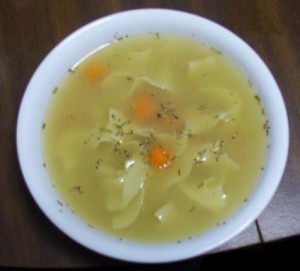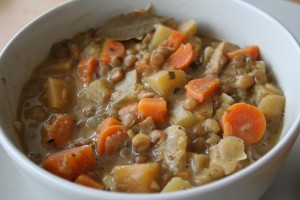As we seem to be headed into a spell of wintry weather, I thought I would reproduce this article, first written for another setting a few years ago.
From The Uxford Mini Dictionary:
Stew n. dish (esp of meat) made by stewing
Soup n. liquid food made from stewed meat or vegetables etc. Soup kitchen n. place where soup is supplied free for the poor
Broth n. thin meat or fish soup. Brothel n. place where broth is sold
Stock n. liquid made by stewing bones, meat, fish or vegetables. Stock exchange n. place where stocks and soups are publicly bought and sold
The above definitions are all very well and good as far as they go, but obviously if you want to be well informed you need more than that, so after extensive research I have the following information to offer:
Broth and stock are at the bottom end of the scale, with typically less than 1 lpp (lump per pint. See below for definitions of lump and pint)
Soup is thicker than stock, yet thinner than stew. There is room for confusion here, as some soups have the lumps mushed into a homogenous slurpy consistency, but the basic original composition of soups (prior to mushing and similar processing) would be between 15 and 35 lpp.
Stew, the most densely packed and most demanding on the dentition, would typically range from 36 to 103lpp.
Lump
A Standard British Lump (SBL) would be about 1cm cube. Of course, some vegetables do not readily lend themselves to lumpitude, but as a rule of thumb, approx 3 peas = 1 lump. 1 medium carrot will yield anything up to 15 lumps. Some cooks prefer to make their lumps larger than Standard British Lump, but they just have to adjust the number of lumps accordingly…
NB. The Standard American Lump (SAL) is approx 4/5 the size of the Standard British Lump (SBL)
(I hope you are following this – there will be questions later!!!)
Pint
The British Imperial Pint (BIP or, in older cookbooks, BP(Imp) ) is 20 fluid ounces.
It follows therefore that the US Pint (USP, but not to be confused with USP, which would make American pints uniquely desirable, which of course is unlikely in the extreme) is 4/5 of the British Imperial Pint (BIP)
I hope those who have been waiting for this information in order to make an informed decision on whether to order stock, broth, soup or stew for dinner have not faded away while waiting.
Of course I cannot accept liability for loss or injury caused by following these guidelines, but any comments and suggestions for revision or further research will be graciously received.
FAQs
What about chowder?
For chowder the rules would still apply. Depending on size of quahaug, bacon dice etc etc and quantity of clams and veg relative to liquid your chowder would either be a soup or a stew. There really is no need or demand for a separate classification!
How do cold soups like gazpacho fit in?
Soup is, by definition, hot. Cold soups are to say the least a contradiction in terms, a nasty foreign anomaly, best ignored in polite society, or at least microwaved discreetly.
You didn’t mention UPS. Are they a company who deliver broth and stew to your house?
Only if you are dyslexic
I’m not sure about the American lump being 4/5ths of the British lump. Don’t Americans like to Super Size everything?
Yes, they do, but mainly by making their measurements smaller.
I think you will find that serving size may well be larger in the US, but I stand by the SBL and SAL figures, which were researched meticulously. Of course, if the serving size is larger, and the lumps are smaller, you will get more lumps per portion, which would be lpp, but that would be very confusing indeed, so after deliberation the International Council for Arbitrary Weights and Measures (ICFAWAM) has decided that this should be designated lps (lumps per serving) Preliminary opinion polls suggest that Americans prefer a higher lps, whereas the British prefer higher lpp values. The debate regarding global standardisation rages on, but as soon as anything is decided, I shall post.
I visited a brothel last week, and chose their ‘Instant hot and spicy’ offering. I am now feeling rather unwell, and have developed a rash. What do you suggest?
Instant soups really should be avoided, as they are a nasty hybrid of reconstituted broth and dried veruccas. As pointed out above in the small print, I can accept no liability for your illness, but I would recommend that you lie down in a quiet place with a bergamot poultice on the affected part.





Great stuff!
🙂 Glad you enjoyed!